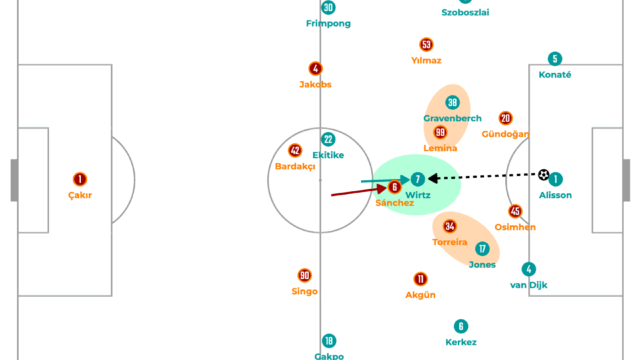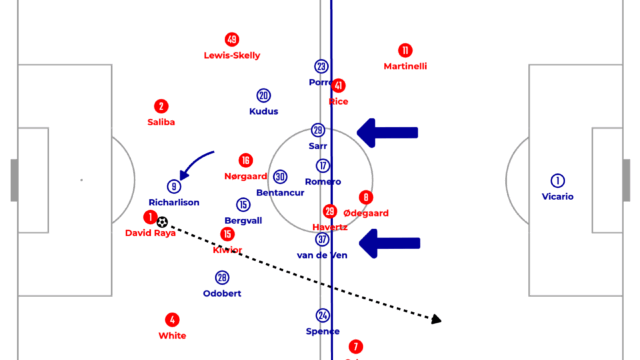The Beauty of Roberto De Zerbi’s Football ~Sharing Space & Helping Each Other~ [Brighton & Hove Albion Tactical Analysis 23-24]
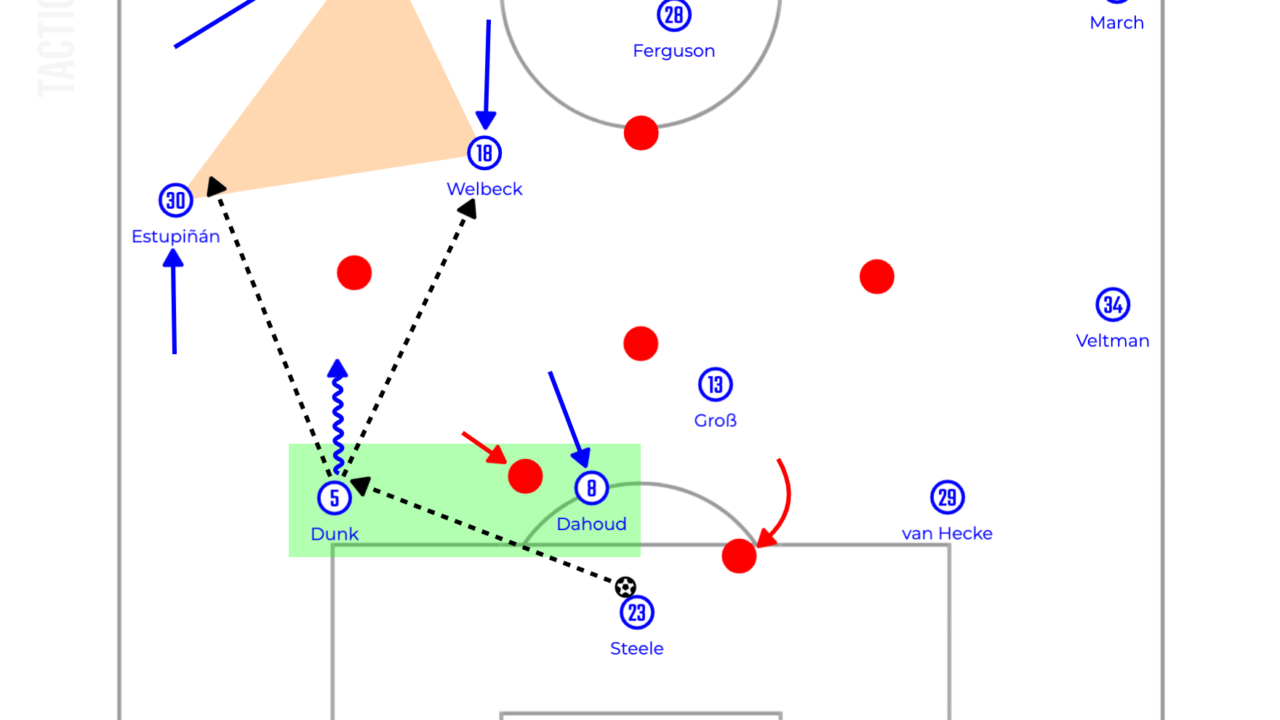
Overall
Roberto De Zerbi’s Brighton is one of the most attracted teams in the world since he took over the team after Graham Potter has left for Chelsea in 22-23 season. His idea has not changed from previous clubs and flourished by beating teams which like to press aggressively. In terms of recent fashion of football, many teams have encouraged to press high to beat so-called ‘Tiki Taka’ football after the domination of Spain and Barcelona a decade ago, and now, the pressing football is destroyed by De Zerbi’s football, which baits the opposition pressure and exploits the space vacated by them in behind.
To be fair, Antonio Conte’s football in possession can be one of the examples which is similar to De Zerbi’s idea, but the reason why Brighton gets so much attention is their dedication to his football, although their business is also incredible. To attract the opposition pressure, his players would wait it forever by controlling the ball under the stud. Additionally, their attacking minded football which they are willing to take a risk and run in behind from the back and sharing the space each other beautifully can be also a reason why they are so respected.
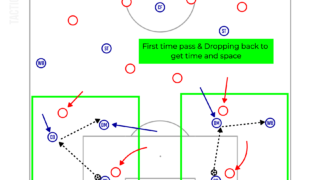
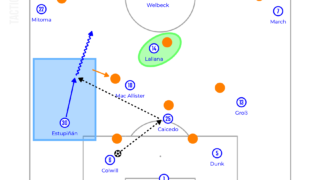
In this article, Roberto De Zerbi’s football is going to be analysed in detail. I hope you will enjoy this discussion.

Build up
His football’s most important part is playing out from the back. From last season, they were exceptional at dragging the opposition pressure out and exploiting the space behind the pressure. However, this season, many teams decided not to press high towards the goalkeeper and chose to stay in front of the 18 yards box to remain more compact. To overcome this opposition solution, his team became able to break the opposition line actively, not by waiting so much.
Firstly, their system of goal kicks is going to be analysed. Recently, the tactics of goal kicks have evolved quickly because all players can position themselves in same positions every time and it is easier to plan how to play out from the back or press high. Brighton have two options. The first one is, very orthodox though, one of the centre backs plays to the goalkeeper. This can prevent the opposition from trying to lock them in because the ball is possessed by the goalkeeper in the middle. The second one is that one of the defensive midfielders drops in the box and he even plays the first pass. This extra player in the box enables it so difficult for the opposition attackers to press high.

When one of the defensive midfielders is in the box, he plays to the goalkeeper or opposite side centre back. After this, he steps out of the box and this causes the problems on the opposition attacker. If the opponent follows his movement, Brighton’s other centre back can have so much time and receive and carry the ball forwards. On the other hand, if the opponent applies pressure on the centre back instead of the defensive midfielder, he can be found by mainly playing a split pass to the dropping striker as a third man who lays it off to the defensive midfielder. Playing to the fullback who will pass horizontally to the defensive midfielder is also an option.
To solve this situation, the opposition needs to place one more player on the edge of the box before the goal kick is restarted, but it will vacate so huge space in between the lines, where Brighton’s strikers can drop and receive a clipped ball. The defending team does not want it to happen, so this strategy is working well for De Zerbi.
When playing out from the back in open play, the objective is attracting the opposition attackers in the middle to create space outside and exploiting it by one of the centre backs carrying the ball or playing a split pass. In order to drag the opposition attackers inside, both two defensive midfielders are positioned in the central lane and the distance between them is so close. From the basic 2-2 shape at the back plus the goalkeeper, one of the defensive midfielders, especially Mahmoud Dahoud or Billy Gilmour drops to position himself between the opposition strikers to attract them in the middle more. This movement is often performed as soon as one of the opposition strikers started to apply pressure on the goalkeeper with a curved run to force him to play the guided side.

Thanks to the dropping defensive midfielder, the opposition attacker is drawn inside, so the centre back can be free and break the opposition first line by going around. And he has three options. Firstly, he can carry the ball forwards, which will force the opposition to drop back into the midfield. Secondly, he can play through to find one of the strikers in between the lines. Thirdly, playing around is another option to break the opposition midfield line. To discuss in detail, it is important to analyse the triangle up front.
The triangle is essential and one of the most important strategies for De Zerbi. By performing this rotation, they can help each other by sharing and using space. The first movement is often the striker dropping in between the lines, especially Danny Welbeck or João Pedro. If nobody marks him, just finding him is the goal of the build up. Even if he is under the pressure and holds up the ball, he can lay it off to one of the defensive midfielders and he can play it outside and they can progress into the midfield. However, normally one of the centre backs steps out tightly to close him down and win the ball.
On the other hand, it means there is a gap in the opposition back line, so the winger makes a diagonal run in behind to exploit it. Additionally, this winger’s movement can force the opposition centre back to stay at the back, which makes the striker in between the lines free. Therefore, it is possible to say that they are helping each other by sharing and using the space.
In addition to them, thanks to the winger’s diagonal movement, the opposition fullback can be dragged inside to follow him. This can open the wide lane where the fullback can exploit by stepping higher and it is possible to break the opposition second line. This relationship among three players is also important when the goalkeeper or centre backs need to play long. Either of fullback or winger is picked up by them when playing over and thanks to the effective movements, it is possible for them to receive a difficult lofted ball in huge space. Overall, the three players up front form the effective triangle and it is working extremely well so far.
Brighton’s most amazing thing is, in my opinion, the simplicity of the system. The ball can be moved various ways, but the organisation is so simple. The five players at the back including the goalkeeper try to attract the opposition first pressing line inside to bypass it and the triangle up front destroys the opposition defensive organisation. Both units are connected by a lay-off from the dropping striker to the defensive midfielder stepping up. Even though the opposition has found a solution against them, which is waiting in front of the edge of the box, De Zerbi has already overcome it.
In terms of the opposition perspective, there are two important things to press well. Firstly, keeping applying pressure on the centre backs tightly. They try to find a way to break the first pressing line by bypassing it, so the distance between the centre backs and goalkeeper is wider. Therefore, it is a tough task for the striker to chase from the goalkeeper to the centre back and if it delays, the centre back on the ball can carry it or play a split pass.
Secondly, closing the dropping striker down tightly to force mistakes or win the ball. If the wide midfielder narrows in to screen the passing lane to the striker, which sounds good, Brighton’s fullback can step higher and receive a split pass to break the second line. Therefore, this route needs to be prevented as well and it will be a job for the centre backs or pivots to manage the pass to the striker. In other words, it needs to be man-marking in a wide area, but it should be accepted. The striker should be closed down tightly to force mistakes. Overall, applying constant pressure on the players at the back and marking tightly the dropping striker who tries to receive the ball in between the lines are extremely important. Or, dropping back and setting a deep defensive block is another passive solution, which was superbly done by West Ham.
Final Third Attacking
In the final third, the biggest difference is the positions of the fullbacks. When playing out from the back, both fullbacks keep the width, but they often come inside in the final third. Additionally, it depends on the situation though, one of the defensive midfielders, especially Pascal Groß positions himself in between the lines and the other stays deeper as a single pivot. Moreover, Groß can be positioned both higher and lower with swapping the right fullback.

This is the basic shape in the final third and one of the main reasons of the inverted fullbacks is just opening the passing lane to the winger. Both fullbacks do not have so much responsibilities of controlling and dictating the game and instead, they sometimes make a run in behind to drag the opposition fullback deeper to give space for the winger to receive a switched ball. Therefore, the task of fullback is giving time and space for the winger.
The combination in wide areas is related to the triangle mentioned in the previous chapter. As soon as the player in a wide area receives the ball, the closest player makes a run in behind through a channel. This can be used simply, but it is often a dummy movement. This movement can open a passing lane to the inside and one of the strikers, Welbeck or Pedro receives it.

Yes, it is so simple again, but they can play multiple roles. The wingers can receive the ball in wide areas and they can also make an underlap run if they are inside and the fullback receives the ball outside, or the strikers can run in behind instead of receiving the ball in between the lines. The pattern is simple, but they do not lose sights even when they are in different positions.
Their tactics of crosses are also effective and insightful. After playing in behind and penetrating into the box, cut backs are often delivered to find the striker who shows up slowly.

Throughout the attacking phase, the striker often drops deeper and even in the final third, he floats in between the lines, so when either of fullback or winger penetrates into the deep area of the box, he is bit far away from the opposition goal. However, De Zerbi uses him as the crucial finisher. Thanks to the vague position in between the lines and his late run into the box, he is often free and unmarked in front of the goal. Therefore, the cut backs are their effective pattern to score goals.
Through the combination, they try to penetrate into the box and attack the opposition centre backs. In addition to this, Mitoma Kaoru can take the opposition fullback on and progress into the deep area of the left side of the box. Their attacking threat is brilliant, but when they stuck in one side, they switch the ball through the defensive midfielder and also Evan Ferguson can pop up as a fourth player to attack the back line.

Overall, their attacking strategy is clear and simple, but so effective. The maturity of tactics in the team is incredible and that is the reason why they are doing so well again this season.
One of the weaknesses is the management of the opposition counterattacks. In the final third, both fullbacks are so aggressive and often make a run in behind. Therefore, it is difficult for them to come back when conceding a counterattack. Additionally, the centre backs Lewis Dunk, Jan Paul van Hecke and Adam Webster are excellent at defending in the box, but they look like they are not good at defending the huge space and quickly closing the opposition attacker on the ball down. Therefore, they often retreat towards the own goal, but as the fullbacks cannot come back quickly because they are too high, the opposition crosses towards the back post area are so dangerous for them.
Pressing
When pressing high, the basic system is a 4-4-2 but they highly focus on marking the opponents instead of being compact as a team. By marking the opponents individually, basically their pressing trigger is a pass to one of the opposition centre backs from the goalkeeper. After that, one of the strikers sometimes applies pressure on the opposition goalkeeper with cutting the passing lane to his previous marker from the opposition goalkeeper.

They mainly win the ball by securing the second ball after forcing the opposition to play long or closing the opposition attacker down after the opposition plays a split pass. However, after failing it, due to the nature of man-marking, there is huge space in between the lines, so it turns into the dangerous situation.
Additionally, as it was mentioned in the previous chapter, the centre backs are not good at defending huge space behind them. Therefore, to be fair, it is a high risk for them to press high.
Final Third Defending
When defending the final third, they still continue their man-oriented approach. However, the difference is the attitude of the centre backs. As they want to keep the line higher, they constantly push the line up as soon as the opposition plays back. The line control is a job for mainly the centre backs, so they focus on it instead of marking the opponents tightly.

Overall, they record more than 60% possession on average, they do not need to care about defending so much, but it is difficult to say that their tactics of out of possession is as good as those of in possession. As a result, however, the game against Aston Villa which they conceded six goals can happen. Even though as a team it is not well organised, in the box, especially Dunk is the main man to block shots or crosses and make it decent. This element is, in my opinion, the next step for them to keep their status in Europe next season. Thank you for reading. I hope you enjoyed this article.
